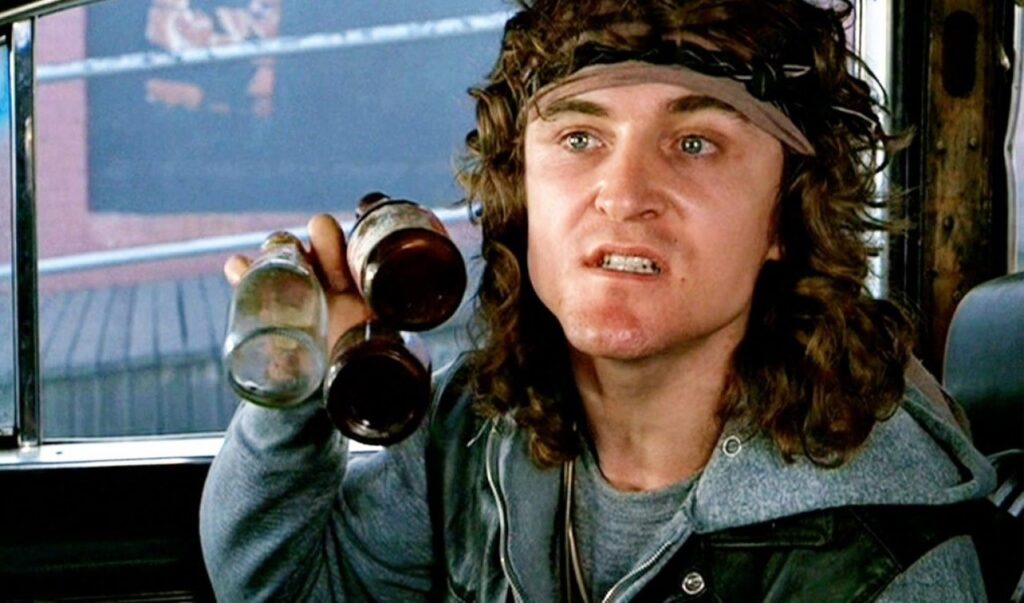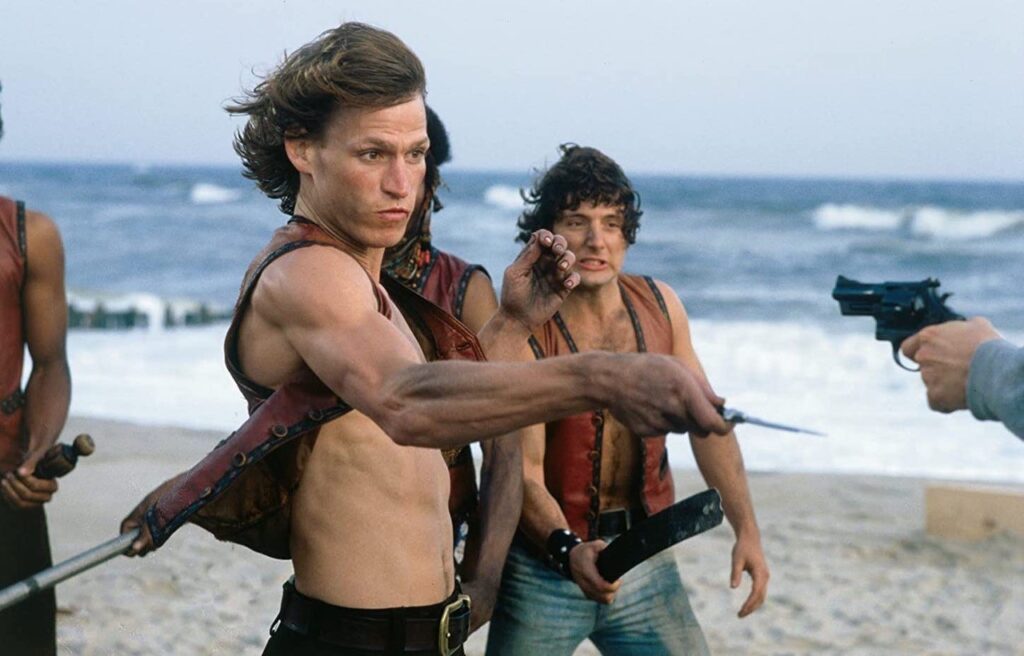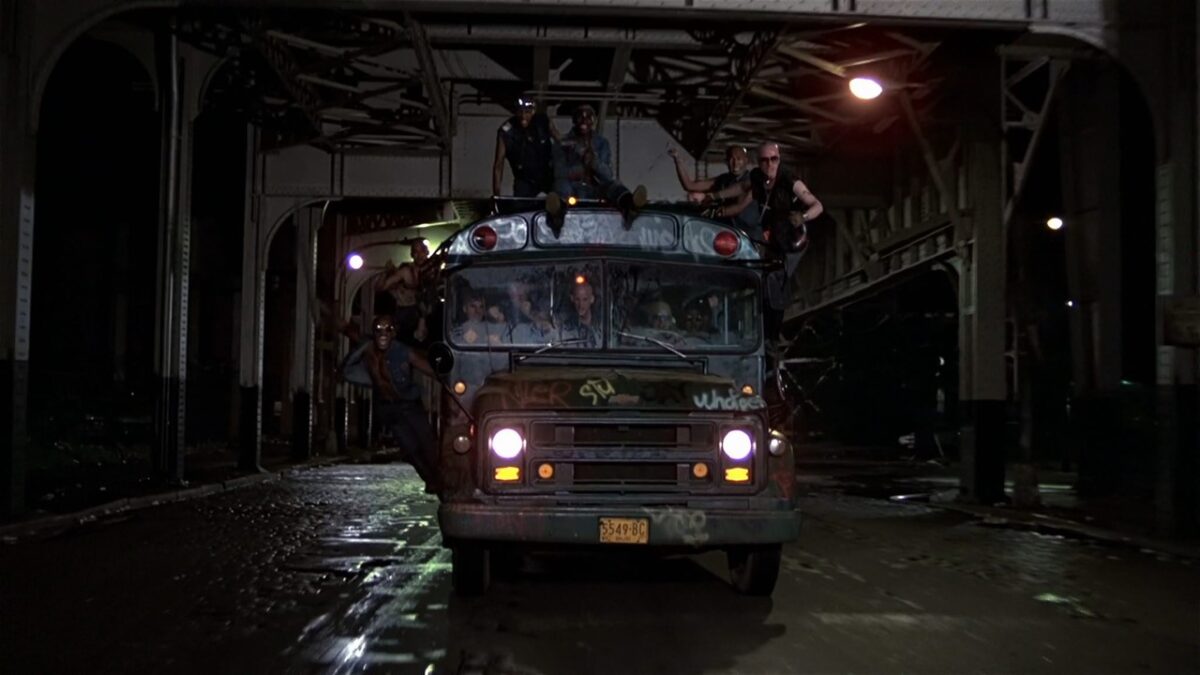Let me flow into the ocean
Let me get back to the sea
Let me be stormy and let me be calm
Let the tide in, and set me free …
– Pete Townshend, “Drowned,” from The Who’s Quadrophenia (1973)
The conflict at the heart of The Warriors (1979) isn’t as simple or straightforward as Mods versus Rockers. It’s the titular New York street gang versus the Turnbull ACs, the Orphans, the Baseball Furies, Lizzies and Punks, not to mention the Gramercy Riffs, Boppers, Jones Street Boys, Panzers, the Van Cortlandt Rangers and more.

Some of these crews look genuinely threatening while others seem overly theatrical if not ludicrous, particularly the Hi-Hats, dressed as top-hatted, white-faced mimes. If a rap battle had ensued – a tad anachronistic for 1979, I will admit – the mimes would surely have been exhausted long before the end of it, like a one-legged man at an ass-kicking contest. Another dubious troupe are the Orphans, who carry press clippings detailing their exploits to impress and/or goad their rivals. And then there’s the overalled Punks – the clash between the Warriors and the Punks may be one of the best choreographed action scenes in the movie but, in the spirit of The Untouchables (1987) and the concept of bringing a knife to a gunfight, who turns up on roller-skates to a switchblade/spray paint/fists/feet/toilet-stall fight?
Our heroes, The Warriors, just want to make it home – back to Coney Island, back to the Wonder Wheel, back to the ocean. Their only problem is that they have been framed for the murder of Riffs War Chief Cyrus, and every other gang in the city is on their tail, thanks to the machinations of Luther (David Patrick Kelly), leader of the renegade Rogues, another candy-ass outfit, who take chocolate bars from a young female shop clerk and refuse to pay. What terrors! What larks!
Despite obvious deficiencies in some of the individual gangs, writer-director Hill’s lean, energetic and always entertaining genre picture reigned among his run of quality actioners of the 1970s and ’80s, which began with The Streetfighter (1975), also known as Hard Times, starring Charles Bronson and James Coburn. Hill followed that with the very influential The Driver (1978), The Warriors, The Long Riders (1980), Southern Comfort (1981), 48HRS (1982) and Streets of Fire (1984). Beyond that he turned out some decent fare, not least Geronimo: An American Legend (1993), with Wes Studi, Jason Patric, Robert Duvall and Gene Hackman. His Bruce Willis starrer, Last Man Standing (1996), also has its fans – the stylish reworking of Kurosawa’s Yojimbo (1961) was one of many Hill films with music by the legendary Ry Cooder. But Hill is still best known for that ’70s-’80s heyday, as well as working as a writer on Sam Peckinpah’s 1972 hit The Getaway, and his producer, screenplay and/or story credits on Alien (1979), Aliens (1986) and subsequent entries in that on-going sci-fi franchise.
The Warriors is one of his most admired, most loved films and a genuine, bona fide cult movie – I know that because it is included in the pages of my well-worn and still often-referred-to copy of Danny Peary’s Cult Movies: A Hundred Ways to Find the Reel Thing (Vermilion & Company, 1982) – it’s right there, slotted in alphabetically between Vertigo (Hitchcock, 1958) and Where’s Poppa? (Carl Reiner, 1970).
Peary points out that the structure of Hill’s film follows that of a baseball game, not simply referring to the aforementioned Yankees-garbed, bat-wielding, face-painted Furies, but because the Warriors must combat their opponents to get to “home”, while negotiating the subway station “bases” and avoiding the cops, or “umpires”, with “play-by-play commentary” courtesy of a gang-friendly radio DJ, who could also be seen as some kind of a modern-day, one-woman Greek Chorus. The 1965 Sol Yurick novel the film is loosely based on (not to be confused with Richard Price’s book The Wanderers, from 1974, also filmed in 1979), refers to Xenophon’s classic tale Anabasis, and there are echoes, too, of Homer’s The Iliad and The Odyssey. James Remar’s alpha male, wimp-bating Warrior is not called “Ajax” for nothing. Remar pouts and poses and rebels like a young Brando, any limited acting skill made up for by seemingly unlimited will.
The bold Peary also describes Kelly’s Luther as “the best wacko villain since Andy Robinson in Dirty Harry (1971)”. But it seems to me that Kelly – who, like Remar, was to become something of a Hill regular – has none of the genuine menace of Robinson’s Scorpio Killer and is instead simultaneously channeling tennis brat John McEnroe and the Wicked Witch of the West from The Wizard of Oz (1939). Or maybe that does add up to genuine menace?! Whatever your take on Kelly, his repeated, crack-voiced challenge of: “Warriors, come out to plaaaaaay!” while clacking glass bottles together must qualify in the category of “once seen and heard, never forgotten”.

The controversy that surrounded The Warriors on its initial release followed reports of vandalism and violent clashes at or around screenings, with a number of homicides somehow linked to an advertising campaign which allegedly fired up the teenage wastelands while terrorising the ordinary and the affluent as it riffed on the idea espoused at the beginning of the movie, that the “armies of the night” far outnumber the cops and could, if they were to become organised, take over New York City. The film itself, though, quickly jettisons this “incendiary” angle to concentrate solely on the fate of the eponymous gang. John Carpenter’s LA-set Assault on Precinct 13 (1976) similarly sets up an early premise of a gang-led, city-wide crisis. A news bulletin warns of a cache of missing automatic weapons and claims that “the juvenile gang problem is completely out of control” before adding: “If the people who have them (the weapons) get organised, no one will stand a chance.” Carpenter, of course, then centres on the subsequent events at the single police station.
Hill’s The Warriors is not an “incendiary” or “violent” film but an “action” film and Hill himself has often said he saw it as something of a fantasy, albeit with “contemporary flash”. Andrew Laszlo’s vibrant photography garishly punctuates the often night-time, rain-soaked street scenes with flashes of primary colours. The comic book transitions of the Ultimate Director’s Cut Blu-ray/DVD may have been part of Hill’s original concept but add little, if anything, to the movie. And if The Warriors was intended as “fantastical”, his Streets Of Fire was even more so, dancing at times uncertainly to an odd musical mix of doo-wop and big-hair soft rock, an ambitious mash-up of time, place and fashion that still delivers as a swooningly romantic, comic book-y tale of passionate kisses in the rain, power ballads worth fighting for and mano-a-mano jousting, villains in black leathers and the hero in white vest, braces and duster.
For The Warriors, the ultimate irony is that when the survivors make it back to Coney, they realise their “little piece of turf” wasn’t really worth the struggle. “Is this what we fought all night to get back to? Maybe I’ll just take off.” Yeah, guys, we’ve all been there.

Back in the late ’70s and early ’80s, “our” gang’s little piece of turf was the cinema, where we spent much of our time, as well as the local bar which, if it had been in a Hill movie, would no doubt have been called Torchy’s. It was film editor and Peckinpah aficionado /scholar Paul Seydor who wrote of Bloody Sam, maker of The Wild Bunch (1969): “Peckinpah has an intuitive grasp not only of the most ancient archetypes and genres – the chase, the hunt, stories of revenge and honour and heroism – but also of the origins of drama in certain kinds of ritual and festival.” Much the same could be said of Hill, and Carpenter, and other filmmakers who championed the action-movie traditions of Hawks, Kurosawa, Peckinpah and Leone.
